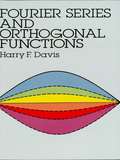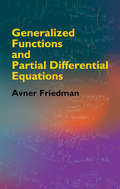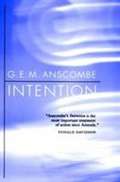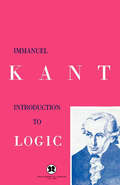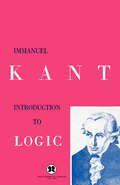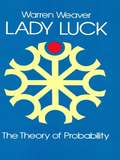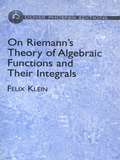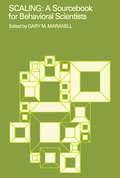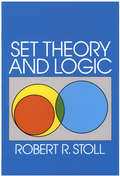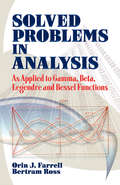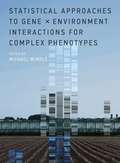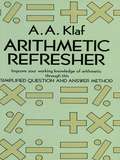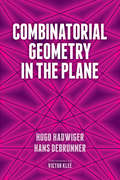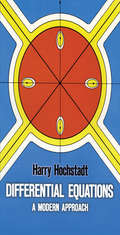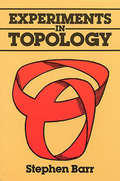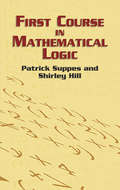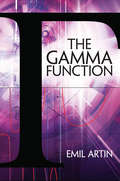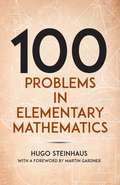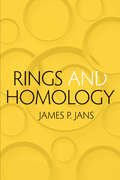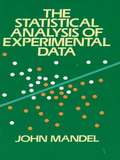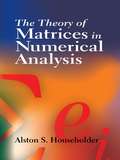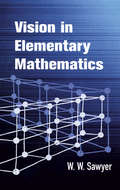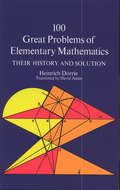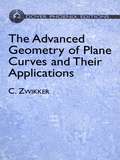- Table View
- List View
Fourier Series and Orthogonal Functions (Dover Books on Mathematics)
by Harry F. DavisThis incisive text deftly combines both theory and practical example to introduce and explore Fourier series and orthogonal functions and applications of the Fourier method to the solution of boundary-value problems. Directed to advanced undergraduate and graduate students in mathematics as well as in physics and engineering, the book requires no prior knowledge of partial differential equations or advanced vector analysis. Students familiar with partial derivatives, multiple integrals, vectors, and elementary differential equations will find the text both accessible and challenging. The first three chapters of the book address linear spaces, orthogonal functions, and the Fourier series. Chapter 4 introduces Legendre polynomials and Bessel functions, and Chapter 5 takes up heat and temperature. The concluding Chapter 6 explores waves and vibrations and harmonic analysis. Several topics not usually found in undergraduate texts are included, among them summability theory, generalized functions, and spherical harmonics. Throughout the text are 570 exercises devised to encourage students to review what has been read and to apply the theory to specific problems. Those preparing for further study in functional analysis, abstract harmonic analysis, and quantum mechanics will find this book especially valuable for the rigorous preparation it provides. Professional engineers, physicists, and mathematicians seeking to extend their mathematical horizons will find it an invaluable reference as well.
Generalized Functions and Partial Differential Equations (Dover Books on Mathematics)
by Avner FriedmanThis self-contained treatment develops the theory of generalized functions and the theory of distributions, and it systematically applies them to solving a variety of problems in partial differential equations. A major portion of the text is based on material included in the books of L. Schwartz, who developed the theory of distributions, and in the books of Gelfand and Shilov, who deal with generalized functions of any class and their use in solving the Cauchy problem. In addition, the author provides applications developed through his own research.Geared toward upper-level undergraduates and graduate students, the text assumes a sound knowledge of both real and complex variables. Familiarity with the basic theory of functional analysis, especially normed spaces, is helpful but not necessary. An introductory chapter features helpful background on topological spaces. Applications to partial differential equations include a treatment of the Cauchy problem, the Goursat problem, fundamental solutions, existence and differentiality of solutions of equations with constants, coefficients, and related topics. Supplementary materials include end-of-chapter problems, bibliographical remarks, and a bibliography.
Intention
by G. E. M. AnscombeIntention is one of the masterworks of twentieth-century philosophy in English. First published in 1957, it has acquired the status of a modern philosophical classic. The book attempts to show in detail that the natural and widely accepted picture of what we mean by an intention gives rise to insoluble problems and must be abandoned. This is a welcome reprint of a book that continues to grow in importance.
Introduction to Logic
by Immanuel Kant T K AbbottWritten during the height of the Enlightenment, Immanuel Kant's Introduction to Logic is an essential primer for anyone interested in the study of Kantian views on logic, aesthetics, and moral reasoning. More accessible than his other books, Introduction to Logic lays the foundation for his writings with a clear discussion of each of his philosophical pursuits. For more advanced Kantian scholars, this book can bring to light some of the enduring issues in Kant's repertoire; for the beginner, it can open up the philosophical ideas of one of the most influential thinkers on modern philosophy. This edition comprises two parts: "Introduction to Logic" and an essay titled "The False Subtlety of the Four Syllogistic Figures," in which Kant analyzes Aristotelian logic.
Introduction to Logic: And His Essay On The Mistaken Subtilty Of The Four Figures
by Immanuel KantThis essential text by one of the founders of modern philosophy offers an accessible introduction to his views on logic, aesthetics, and morality. Written during the height of the Enlightenment, Immanuel Kant&’s Introduction to Logic is a clear and concise primer for his larger works Critique of Pure Reason and Groundwork for the Metaphysics of Morals. More accessible than his other books, it provides definitions of Kantian terms and a clear discussion of each of his philosophical pursuits. For more advanced Kantian scholars, this book can bring to light some of the enduring issues in Kant&’s repertoire; for the beginner, it can open up the philosophical ideas of one of the most influential thinkers on modern philosophy. This edition comprises two parts: &“Kant&’s Introduction to Logic&” and an essay titled &“The Mistaken Subtilty of the Four Syllogistic Figures,&” in which Kant analyzes Aristotelian logic.
Lady Luck: The Theory of Probability
by Warren Weaver"Should I take my umbrella?" "Should I buy insurance?" "Which horse should I bet on?" Every day - in business, in love affairs, in forecasting the weather or the stock market questions arise which cannot be answered by a simple "yes" or "no." Many of these questions involve probability. Probabilistic thinking is as crucially important in ordinary affairs as it is in the most abstruse realms of science. This book is the best nontechnical introduction to probability ever written. Its author, the late Dr. Warren Weaver, was a professor of mathematics, active in the Rockefeller and Sloan foundations , an authority on communications and probability, and distinguished for his work at bridging the gap between science and the average citizen. In accessible language and drawing upon the widely diverse writings of thinkers like Kurt Godel, Susanne K.Langer, and Nicholas Bernoulli, Dr. Weaver explains such concepts as permutations, independent events, mathematical expectation, the law of averages, Chebychev's theorem, the law of large numbers, and probability distributions. He uses a probabilistic viewpoint to illuminate such matters as rare events and coincidences, and also devotes space to the relations of probability and statistics, gambling, and modern scientific research. Dr. Weaver writes with wit, charm and exceptional clarity. His mathematics is elementary, grasp of the subject profound, and examples fascinating. They are complemented by 49 delightful drawings by Peg Hosford. 13 tables. 49 drawings. Foreword. Index.
On Riemann's Theory of Algebraic Functions and Their Integrals: A Supplement to the Usual Treatises (Dover Books on Mathematics)
by Felix KleinA consideration of the investigations in the first part of Riemann's Theory of Abelian Functions, this volume introduces Riemann's approach to multiple-value functions and the geometrical representation of these functions by what later became known as Riemann surfaces. It further concentrates on the kinds of functions that can be defined on these surfaces, confining the treatment to rational functions and their integrals, and then demonstrates how Riemann's mathematical ideas about Abelian integrals can be arrived at by thinking in terms of the flow of electric current on surfaces. Deeply significant in the area of complex functions, this work constitutes one of the best introductions to the origins of topological problems. Unabridged republication of the classic 1893 edition. 43 figures. Glossary.
Scaling: A Sourcebook for Behavioral Scientists (Neural Information Processing Ser.)
by Peter Jordan Caroline LloydDespite the obvious importance of measurement in any scientific endeavor, few students of the social sciences receive adequate training in the principles and problems of assigning numerical values to the subjects, objects, events, groups and operations they study, and still less in the process of translating theoretical ideas and concepts into variables. This kind of casualness with respect to measurement is often in marked contrast to their methodically designed research, which has grown out of subtle and sophisticated theoretical consideration.Scaling is intended to remedy this deficiency by providing a broad and detailed description of the major processes for developing measurement scales. The chapters, which include both classics in the field and the best of modern work, require no great mathematical sophistication, and go well beyond the conventional study of attitudes to the more general uses of scaling. They enable the student and researcher to examine the development of measures of scalability and the problems and weaknesses they present, to become familiar with the development of tests of significance for reproducibility and scalability and the need for them, and to examine the lively history of the subject and experience the excitement that can be secured from sharing with a creative author the first report of his insight.Part One presents a series of general articles that deal in philosophic terms with the problem of measurement, with what is meant by measurement and scaling as well as the notions underlying the process of measuring. Part Two deals with the scaling methods developed by L. L. Thurstone, including paired comparison scaling, equal-appearing interval scaling, and successive interval scaling. The third part focuses upon scalogram analysis, presenting the background, rationale and procedures for Guttman scaling. The fourth part is concerned with summated rating, or Likert scaling. Part Five is a consideration of unfold
Set Theory and Logic
by Robert R. StollSet Theory and Logic is the result of a course of lectures for advanced undergraduates, developed at Oberlin College for the purpose of introducing students to the conceptual foundations of mathematics. Mathematics, specifically the real number system, is approached as a unity whose operations can be logically ordered through axioms. One of the most complex and essential of modern mathematical innovations, the theory of sets (crucial to quantum mechanics and other sciences), is introduced in a most careful concept manner, aiming for the maximum in clarity and stimulation for further study in set logic. Contents include: Sets and Relations -- Cantor's concept of a set, etc.Natural Number Sequence -- Zorn's Lemma, etc.Extension of Natural Numbers to Real NumbersLogic -- the Statement and Predicate Calculus, etc.Informal Axiomatic MathematicsBoolean AlgebraInformal Axiomatic Set TheorySeveral Algebraic Theories -- Rings, Integral Domains, Fields, etc.First-Order Theories -- Metamathematics, etc.Symbolic logic does not figure significantly until the final chapter. The main theme of the book is mathematics as a system seen through the elaboration of real numbers; set theory and logic are seen s efficient tools in constructing axioms necessary to the system. Mathematics students at the undergraduate level, and those who seek a rigorous but not unnecessarily technical introduction to mathematical concepts, will welcome the return to print of this most lucid work. "Professor Stoll . . . has given us one of the best introductory texts we have seen." -- Cosmos. "In the reviewer's opinion, this is an excellent book, and in addition to its use as a textbook (it contains a wealth of exercises and examples) can be recommended to all who wish an introduction to mathematical logic less technical than standard treatises (to which it can also serve as preliminary reading)." -- Mathematical Reviews.
Solved Problems in Analysis: As Applied to Gamma, Beta, Legendre and Bessel Functions (Dover Books on Mathematics)
by Orin J. Farrell Bertram RossNearly 200 problems, each with a detailed, worked-out solution, deal with the properties and applications of the gamma and beta functions, Legendre polynomials, and Bessel functions. The first two chapters examine gamma and beta functions, including applications to certain geometrical and physical problems such as heat-flow in a straight wire. The following two chapters treat Legendre polynomials, addressing applications to specific series expansions, steady-state heat-flow temperature distribution, gravitational potential of a circular lamina, and application of Gauss's mechanical quadrature formula with pertinent table. The final chapters explore Bessel functions, discussing differentiation formulas, generating functions, relations to Legendre polynomials, and other applications.This volume constitutes a useful tool for professional engineers and experimental physicists. Students of mathematics, physics, and engineering will particularly benefit from the book's expanded solutions.
Statistical Approaches to Gene x Environment Interactions for Complex Phenotypes
by Michael WindleFindings from the Human Genome Project and from Genome-Wide Association (GWA) studies indicate that many diseases and traits manifest a more complex genomic pattern than previously assumed. These findings, and advances in high-throughput sequencing, suggest that there are many sources of influence -- genetic, epigenetic, and environmental. This volume investigates the role of the interactions of genes and environment (G × E) in diseases and traits (referred to by the contributors as complex phenotypes) including depression, diabetes, obesity, and substance use. The contributors first present different statistical approaches or strategies to address G × E and G × G interactions with high-throughput sequenced data, including two-stage procedures to identify G × E and G × G interactions, marker-set approaches to assessing interactions at the gene level, and the use of a partial-least square (PLS) approach. The contributors then turn to specific complex phenotypes, research designs, or combined methods that may advance the study of G × E interactions, considering such topics as randomized clinical trials in obesity research, longitudinal research designs and statistical models, and the development of polygenic scores to investigate G × E interactions.ContributorsFatima Umber Ahmed, Yin-Hsiu Chen, James Y. Dai, Caroline Y. Doyle, Zihuai He, Li Hsu, Shuo Jiao, Erin Loraine Kinnally, Yi-An Ko, Charles Kooperberg, Seunggeun Lee, Arnab Maity, Jeanne M. McCaffery, Bhramar Mukherjee, Sung Kyun Park, Duncan C. Thomas, Alexandre Todorov, Jung-Ying Tzeng, Tao Wang, Michael Windle, Min Zhang
Arithmetic Refresher (Dover Books on Mathematics)
by A. A. KlafThe farther we get from our grade school days, the easier it is to forget those operations and nuances of arithmetical computation that keep recurring in our daily lives: interest and discount problems, time-payment calculations, tax problems, and so on.This handy book is designed to streamline your methods and resharpen your calculation skills for a variety of situations. Starting with the most elementary operations, the book goes on to cover all basic topics and processes of arithmetic: addition, subtraction, multiplication, division, fractions, percentage, interest, ratio and proportion, denominate numbers, averages, etc. The text continues into other useful matters, such as powers and roots, logarithms, positive and negative numbers, harmonic progression, and introductory concepts of algebra.Entirely practical in approach and using an easy-to-follow question and answer style, this book covers a wide range of common knotty areas: filling and emptying receptacles, scales for models and maps, business and financial calculations (partial payment problems, compound interest, bank and sales discount, profit and loss problems, etc.), angle measurement, mixtures and solutions, graph and chart problems, and the like.The discussion contains numerous alternate and short-cut methods, such as quick ways to figure compound interest; to square a number from 1 to 100; to divide by 5, 25, 125, 99, etc.; to multiply two 2-digit numbers having the same figure in the tens place; and many more. These valuable tips, together with the huge fund of exercise problems (a total of 809, half of them answered in an appendix), help you to increase your computational proficiency and speed, and make this an extremely useful volume to have on your shelf at home or at work. Anyone who has to do any figuring at all -- housewife, merchant, student -- will profit from this refresher. Parents will find it an excellent source of material for helping children in school work.
Combinatorial Geometry in the Plane (Dover Books on Mathematics)
by Hans Debrunner Hugo Hadwiger Victor KleeGeared toward advanced undergraduates familiar with analysis and college geometry, this concise book discusses theorems on topics restricted to the plane such as convexity, coverings, and graphs. In addition to helping students cultivate rigorous thought, the text encourages the development of mathematical intuition and clarifies the nature of mathematical research.The two-part treatment begins with specific topics including integral distances, covering problems, point set geometry and convexity, simple paradoxes involving point sets, and pure combinatorics, among other subjects. The second part consists of an extensive section of short proofs concerning the earlier material.
A Course in Modern Mathematical Physics
by Peter SzekeresPresenting an introduction to the mathematics of modern physics for advanced undergraduate and graduate students, this textbook introduces the reader to modern mathematical thinking within a physics context. Topics covered include tensor algebra, differential geometry, topology, Lie groups and Lie algebras, distribution theory, fundamental analysis and Hilbert spaces. The book also includes exercises and proofed examples to test the students' understanding of the various concepts, as well as to extend the text's themes.
Differential Equations
by Harry HochstadtModern approach to differential equations presents subject in terms of ideas and concepts rather than special cases and tricks which traditional courses emphasized. No prerequisites needed other than a good calculus course. Certain concepts from linear algebra used throughout. Problem section at end of each chapter.
Experiments in Topology
by Stephen Barr"A mathematician named KleinThought the Moebius band was divine.Said he: 'If you glueThe edges of two,You'll get a weird bottle like mine.' " -- Stephen BarrIn this lively book, the classic in its field, a master of recreational topology invites readers to venture into such tantalizing topological realms as continuity and connectedness via the Klein bottle and the Moebius strip. Beginning with a definition of topology and a discussion of Euler's theorem, Mr. Barr brings wit and clarity to these topics:New Surfaces (Orientability, Dimension, The Klein Bottle, etc.)The Shortest Moebius StripThe Conical Moebius StripThe Klein BottleThe Projective Plane (Symmetry)Map ColoringNetworks (Koenigsberg Bridges, Betti Numbers, Knots)The Trial of the Punctured TorusContinuity and Discreteness ("Next Number," Continuity, Neighborhoods, Limit Points)Sets (Valid or Merely True? Venn Diagrams, Open and Closed Sets, Transformations, Mapping, Homotopy)With this book and a square sheet of paper, the reader can make paper Klein bottles, step by step; then, by intersecting or cutting the bottle, make Moebius strips. Conical Moebius strips, projective planes, the principle of map coloring, the classic problem of the Koenigsberg bridges, and many more aspects of topology are carefully and concisely illuminated by the author's informal and entertaining approach.Now in this inexpensive paperback edition, Experiments in Topology belongs in the library of any math enthusiast with a taste for brainteasing adventures in the byways of mathematics.
First Course in Mathematical Logic (Dover Books on Mathematics)
by Patrick Suppes Shirley HillIn modern mathematics, both the theory of proof and the derivation of theorems from axioms bear an unquestioned importance. The necessary skills behind these methods, however, are frequently underdeveloped. This book counters that neglect with a rigorous introduction that is simple enough in presentation and context to permit relatively easy comprehension. It comprises the sentential theory of inference, inference with universal quantifiers, and applications of the theory of inference developed to the elementary theory of commutative groups. Throughout the book, the authors emphasize the pervasive and important problem of translating English sentences into logical or mathematical symbolism. Their clear and coherent style of writing ensures that this work may be used by students in a wide range of ages and abilities.
The Gamma Function (Dover Books on Mathematics)
by Emil Artin Michael ButlerThis brief monograph on the gamma function was designed by the author to fill what he perceived as a gap in the literature of mathematics, which often treated the gamma function in a manner he described as both sketchy and overly complicated. Author Emil Artin, one of the twentieth century's leading mathematicians, wrote in his Preface to this book, "I feel that this monograph will help to show that the gamma function can be thought of as one of the elementary functions, and that all of its basic properties can be established using elementary methods of the calculus." Generations of teachers and students have benefitted from Artin's masterly arguments and precise results. Suitable for advanced undergraduates and graduate students of mathematics, his treatment examines functions, the Euler integrals and the Gauss formula, large values of x and the multiplication formula, the connection with sin x, applications to definite integrals, and other subjects.
One Hundred Problems in Elementary Mathematics (Dover Books on Mathematics)
by Martin Gardner Hugo SteinhausBoth a challenge to mathematically inclined readers and a useful supplementary text for high school and college courses, One Hundred Problems in Elementary Mathematics presents an instructive, stimulating collection of problems. Many problems address such matters as numbers, equations, inequalities, points, polygons, circles, ellipses, space, polyhedra, and spheres. An equal number deal with more amusing or more practical subjects, such as a picnic ham, blood groups, rooks on a chessboard, and the doings of the ingenious Dr. Abracadabrus.Are the problems in this book really elementary? Perhaps not in the lay reader’s sense, for anyone who desires to solve these problems must know a fair amount of mathematics, up to calculus. Nevertheless, Professor Steinhaus has given complete, detailed solutions to every one of his 100 problems, and anyone who works through the solutions will painlessly learn an astonishing amount of mathematics. A final chapter provides a true test for the most proficient readers: 13 additional unsolved problems, including some for which the author himself does not know the solutions.
Rings and Homology (Dover Books on Mathematics)
by James P. JansThis concise text is geared toward students of mathematics who have completed a basic college course in algebra. Combining material on ring structure and homological algebra, the treatment offers advanced undergraduate and graduate students practice in the techniques of both areas. After a brief review of basic concepts, the text proceeds to an examination of ring structure, with particular attention to the structure of semisimple rings with minimum condition. Subsequent chapters develop certain elementary homological theories, introducing the functor Ext and exploring the various projective dimensions, global dimension, and duality theory. Each chapter concludes with a set of exercises.
The Statistical Analysis of Experimental Data
by John MandelThe increasing importance in laboratory situations of minutely precise measurements presents the chemist and physicist with numerous problems in data analysis. National Bureau of Standards statistics consultant John Mandel here draws a clear and fascinating blueprint for a systematic science of statistical analysis -- geared to the particular needs of the physical scientist, with approach and examples aimed specifically at the statistical problems he is likely to confront. The first third of The Statistical Analysis of Experimental Data comprises a thorough grounding in the fundamental mathematical definitions, concepts, and facts underlying modern statistical theory -- math knowledge beyond basic algebra, calculus, and analytic geometry is not required. Remaining chapters deal with statistics as an interpretative tool that can enable the laboratory researcher to determine his most effective methodology. You'll find lucid, concise coverage of over 130 topics, including elements of measurement; nature of statistical analysis; design/analysis of experiments; statistics as diagnostic tool; precision and accuracy; testing statistical models; between-within classifications; two-way classifications; sampling (principles, objectives, methods); fitting of non-linear models; measurement of processes; components of variance; nested designs; the sensitivity ratio, and much more.Also included are many examples, each worked in step-by-step fashion; nearly 200 helpful figures and tables; and concluding chapter summaries followed by references for further study.Mandel argues that, when backed by an understanding of its theoretic framework, statistics offers researchers "not only a powerful tool for the interpretation of experiments but also a task of real intellectual gratification." The Statistical Analysis of Experimental Data provides the physical scientist with the explanations and models he requires to impress this invaluable tool into service.
The Theory of Matrices in Numerical Analysis
by Alston S. HouseholderThis text explores aspects of matrix theory that are most useful in developing and appraising computational methods for solving systems of linear equations and for finding characteristic roots. Suitable for advanced undergraduates and graduate students, it assumes an understanding of the general principles of matrix algebra, including the Cayley-Hamilton theorem, characteristic roots and vectors, and linear dependence.An introductory chapter covers the Lanczos algorithm, orthogonal polynomials, and determinantal identities. Succeeding chapters examine norms, bounds, and convergence; localization theorems and other inequalities; and methods of solving systems of linear equations. The final chapters illustrate the mathematical principles underlying linear equations and their interrelationships. Topics include methods of successive approximation, direct methods of inversion, normalization and reduction of the matrix, and proper values and vectors. Each chapter concludes with a helpful set of references and problems.
Vision in Elementary Mathematics (Dover Books on Mathematics)
by W. W. SawyerHere is a presentation of elementary mathematics that anyone can appreciate, especially anyone with a capacity for imagination. As the title suggests, the author's technique relies on visual elements, and his approach employs the most graphic and least forbidding aspects of mathematics. Most people, he observes, possess a direct vision that permits them to "see" the smaller numbers; with the larger numbers, however, vision fails and mental chaos ensues. In addressing this difficulty, both for those who like recreational mathematics and particularly for teachers, the author suggests a variety of methods already used by many effective teachers -- techniques of visualizing, dramatizing, and analyzing numbers that attract and retain the attention and understanding of children. His topics range from basic multiplication and division to algebra, encompassing word problems, graphs, negative numbers, fractions, and many other practical applications of elementary mathematics.
100 Great Problems of Elementary Mathematics
by Heinrich Dörrie"The collection, drawn from arithmetic, algebra, pure and algebraic geometry and astronomy, is extraordinarily interesting and attractive." -- Mathematical GazetteThis uncommonly interesting volume covers 100 of the most famous historical problems of elementary mathematics. Not only does the book bear witness to the extraordinary ingenuity of some of the greatest mathematical minds of history -- Archimedes, Isaac Newton, Leonhard Euler, Augustin Cauchy, Pierre Fermat, Carl Friedrich Gauss, Gaspard Monge, Jakob Steiner, and many others -- but it provides rare insight and inspiration to any reader, from high school math student to professional mathematician. This is indeed an unusual and uniquely valuable book.The one hundred problems are presented in six categories: 26 arithmetical problems, 15 planimetric problems, 25 classic problems concerning conic sections and cycloids, 10 stereometric problems, 12 nautical and astronomical problems, and 12 maxima and minima problems. In addition to defining the problems and giving full solutions and proofs, the author recounts their origins and history and discusses personalities associated with them. Often he gives not the original solution, but one or two simpler or more interesting demonstrations. In only two or three instances does the solution assume anything more than a knowledge of theorems of elementary mathematics; hence, this is a book with an extremely wide appeal.Some of the most celebrated and intriguing items are: Archimedes' "Problema Bovinum," Euler's problem of polygon division, Omar Khayyam's binomial expansion, the Euler number, Newton's exponential series, the sine and cosine series, Mercator's logarithmic series, the Fermat-Euler prime number theorem, the Feuerbach circle, the tangency problem of Apollonius, Archimedes' determination of pi, Pascal's hexagon theorem, Desargues' involution theorem, the five regular solids, the Mercator projection, the Kepler equation, determination of the position of a ship at sea, Lambert's comet problem, and Steiner's ellipse, circle, and sphere problems.This translation, prepared especially for Dover by David Antin, brings Dörrie's "Triumph der Mathematik" to the English-language audience for the first time.
The Advanced Geometry of Plane Curves and Their Applications (Dover Books on Mathematics)
by C. Zwikker"Of chief interest to mathematicians, but physicists and others will be fascinated ... and intrigued by the fruitful use of non-Cartesian methods. Students ... should find the book stimulating." -- British Journal of Applied PhysicsThis study of many important curves, their geometrical properties, and their applications features material not customarily treated in texts on synthetic or analytic Euclidean geometry. Its wide coverage, which includes both algebraic and transcendental curves, extends to unusual properties of familiar curves along with the nature of lesser known curves.Informative discussions of the line, circle, parabola, ellipse, and hyperbola presuppose only the most elementary facts. The less common curves -- cissoid, strophoid, spirals, the leminscate, cycloid, epicycloid, cardioid, and many others -- receive introductions that explain both their basic and advanced properties. Derived curves-the involute, evolute, pedal curve, envelope, and orthogonal trajectories-are also examined, with definitions of their important applications. These range through the fields of optics, electric circuit design, hydraulics, hydrodynamics, classical mechanics, electromagnetism, crystallography, gear design, road engineering, orbits of subatomic particles, and similar areas in physics and engineering. The author represents the points of the curves by complex numbers, rather than the real Cartesian coordinates, an approach that permits simple, direct, and elegant proofs.
